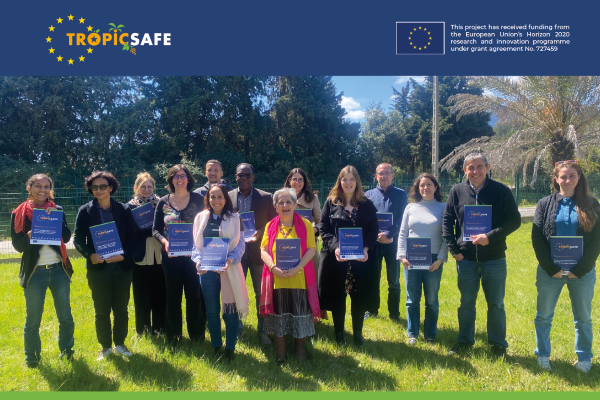For five years, the TROPICSAFE project, funded by the European Union’s Horizon 2020 research and innovation programme and coordinated by Prof. Assunta Bertaccini (University of Bologna, Italy), studied three economically important insect-borne prokaryote-associated diseases of perennial crops grown in tropical and subtropical areas. Diverse ‘Candidatus Phytoplasma’ species associated with lethal yellowing in coconut palms and yellows in grapevine, and ‘Ca. Liberibacter’ species associated with “huanglongbing” in citrus were detected and studied.
During the last decades, these are the diseases most seriously affecting the worldwide trade and import of products and materials from these crops, because of the globalization of trade and climate change. For their effective, efficient and sustainable management, important knowledge gaps were filled working in Africa (Ghana, South Africa and Mozambique), America (Mexico, Chile) and the Caribbean (Guadeloupe, Jamaica, Cuba), as well as in Europe (Spain and Italy).
Monitoring and developing specific diagnostic methods allowed the identification of the different bacteria associated with these diseases in the various ecosystems studied. New insect vectors and alternative host plant species of the studied pathogens were also identified. The knowledge acquired in this project will allow more specific, and environmentally friendly disease management reducing the insecticide treatments. Preliminary studies carried out on the bacterial microbiome of the healthy and infected plants in the different ecosystems also open the way to innovative and specific control methodologies.
The results obtained were presented in a final conference organized over three days at the CIRAD-INRA centre in San Giuliano in Corsica. The conference recordings are now available on the project website and YouTube channel. A brief summary of the results achieved by the 22 partners from 12 countries is also included in this article, discover the main findings per crop!
Lethal yellowing of coconut palms
The project surveys in Africa resulted in the identification of ‘Ca. P. palmicola’ strains in coconut palms in Ghana and in Mozambique. In Ghana alternative plant host species and putative insect vectors, respectively were identified. Evaluation of four dwarf coconut varieties showed that all of them have the potential to be used in rehabilitating the coconut industry in Ghana. In Cuba, Jamaica and Mexico ‘Ca. P. palmae’ was detected in coconut and other palm species, and Haplaxius crudus was confirmed as insect vector in Mexico and Cuba. In Jamaica Stachytarpheta jamaicensis and Cleome rutidosperma were harbouring the phytoplasma, while H. crudus and Oecleus mackaspringii are its possible insect vectors.
In Mexico alternative plant host species were identified come of which are hosting nymphs of H. crudus; several putative alternative insect vectors were also identified. Different palm ecotypes are under field evaluation for resistance also using specifically developed molecular markers. Resistant germplasm from Mexico has been transferred as in vitro plants to Cuba and Jamaica to compare its performance in diverse geographic areas. A new LAMP diagnostic assay for specifically detect the phytoplasma was applied in Ghana. A qPCR multiplex methodology, based on the secA gene, to distinguish between 16SrIV-A and 16SrIV-D phytoplasmas, was developed in Mexico.
In South Africa the ‘Ca. P. asteris’ was detected in Mesembryanthemum crystallinum, Protea cynaroides, and Raphanus sativus; it was also identified in the insects Aconurella prolixa and Exitianus sp. The most abundant insect species in vineyards was the insect vector Mgenia fuscovaria. A seasonal management plan has been developed including recommendations for leafhopper monitoring, weed control, sanitation, and chemical control. Plant-derived antimicrobial peptides were prepared and preliminary screenings against phytoplasma-containing colonies were performed. The LAMP and qPCR assays developed in the project for specific detection of the ‘Ca. P. asteris’ South African strain were tested on synthetic target DNA, DNA samples from different phytoplasmas, and on grapevine. In Chile alternative host plants for the ‘Ca. P. pruni’ strain detected (16SrIII-J) were Convolvulus arvensis, Galega officinalis, Polygonum aviculare, Brassica rapa, Malva sp., Erodium cicutarium, Rosa sp. and Rubus ulmifolius. Amplicephalus curtulus, A. ornatus, A. pallidus, Exitianus obscurinervis, Bergallia sp., and Paratanus exitiosus were identified as insect vectors or potential vectors of this phytoplasma, the dominant species being P. exitiosus, followed by A. curtulus.
In Italy plants and insect samples collected in vineyards and positive for the presence of diverse grapevine phytoplasmas belonged to 16 and 12 species, respectively. The main phytoplasma diseases target for management and detection were “bois noir” and “flavescence dorée”. An experimental vineyard obtained with the F1 crossing population between genotypes with differential susceptibility to grapevine yellows was infected using insect vectors. Genotyping the individuals of the F1 population was carried out on 300 biotypes, while phenotyping is ongoing in the field. Merging the two kinds of data is helping us in the identification of the genetic traits putatively associated to grapevine yellow resistance. A new ELISA kit was developed, targeting “flavescence dorée” phytoplasmas. To assess the analytical performances of the developed serological detection protocol for phytoplasmas, a comparative analysis of the ELISA versus qPCR was carried out using grapevine, other plant and insect samples, and gave good results. Antisera produced using phytoplasma colonies of ‘Ca. P. asteris’ were tested by the immunoflourescence assay (IFAS) and were able to detect the agent in colonies containing the phytoplasma and in periwinkle phytoplasma infected samples.
Citrus “huanglongbing” disease
Surveys in citrus orchards confirmed the presence of ‘Ca. L. africanus’ in South Africa and ‘Ca. L. asiaticus’ in Guadeloupe, Jamaica, Mexico and Cuba, but none of these bacteria was detected in the surveys carried out in five citrus-growing regions of Chile and in Spain. Surveys did not result in the detection of alternative insect or plant host species. The presence of the known vectors Diaphorina citri in Cuba, Mexico, and Guadeloupe, and Trioza erytreae in South Africa and in Spain was confirmed. Since native parasitoids of T. erytreae were not identified in Spain, Tamarixia dryi from South Africa was introduced and showed good dispersion and parasitism efficacy in the Canary Islands first, and in Spain later. The seasonal trend of T. erytreae determined in the Canary Islands indicated between four and five generations per year, but its population remained very low after the summer. A survey for the disease presence in the main citrus producing areas of Cuba confirmed its presence throughout the island. The seasonal trend of D. citri was connected to management strategies, and irrigation or rains. Elimination of the symptomatic trees at a regional scale resulted in the best management strategy.
The efficacy of kaolin against D. citri resulted keeping the infestation level very low for two years. In Guadeloupe, despite the relatively low abundance of D. citri in some orchards under an integrated pest management program, the disease levels and mortality of the citrus trees were very high. Different combinations of rootstocks/varieties were selected and, after four years from plantation, all the trees became infected although they were asymptomatic and had fruits. The quantitative PCR analysis revealed the presence of a low concentration of ‘Ca. L. asiaticus’; the relationship between “huanglongbing” susceptibility and anatomical, physiological, and metabolomic traits with a special focus on the potential impact of polyploidy on tolerance to the disease, was determined. A PCR assay to detect ‘Ca. L. africanus’ and its local subspecies was developed in South Africa.








